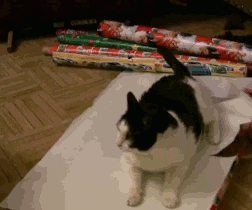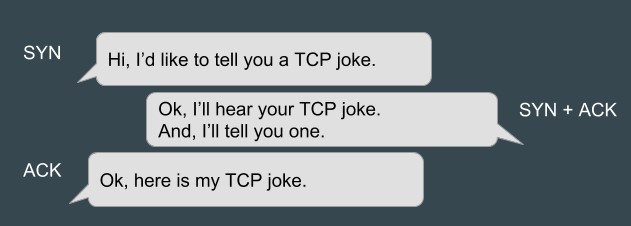Being born in the 90s, I’ve lived most of my life in a post-Internet world. I do remember the sweet sound of 56 kb/s modem, but most of my browsing time has been after the dial-up era.
Internet, for my generation, is just an inherent part of life. It’s kind of hard to imagine what it was like before (did people actually read books?), and we never pause to think:
Wait, how does the Internet even work?
So that’s exactly the subject of this post. Buckle up your seatbelt, we’re going deep into networking!
We’ll examine two aspects of the Internet:
- how data is transferred over the network
- how users can access a webpage
Table of Contents:
How data is transferred over a network
What happens when you type a URL into your browser?
Let’s assume you want to reach Twitter, and typed https://twitter.com/home
into your browser.
URL Parsing
The first thing your browser does is parse the URL, in order to extract its components:
- the scheme (
https), which informs the browser that we want to use the HyperText Transfor Protocol Secure to exchange data with the server; - the host (
twitter.com), which is the computer that hosts the resources of this website (eg. the HTML, the pictures, etc.); - the path (
/home), which corresponds to the particular resource we want to access.
DNS Lookup
The domain name (twitter.com) typed is nothing more than a human-friendly name
that refers to a server somewhere on the Internet.
In order for data to be transferred to this server, we need to know
its IP address. IP addresses (v4) are sets of 4 numbers (from 0 to 255)
separated by dots ., like 104.244.42.193. This logicial address is unique
and allows to locate a device on the internet.
As IP addresses would be hard to remember for humans with limited memory slots, we use domain names to cover up this complexity. But how do we convert a domain name into an IP address?
That’s where DNS (Domain Name System) comes in! The DNS is a distributed database which translates a domain name into an IP address.
When you typed https://twitter.com/home into your browser, it first checked
whether twitter.com was already available in its cache (from a previous
browsing session). If it wasn’t, the browser used its DNS provider in order
to find the IP address associated with the domain name (and cached the answer
for later use).
Encapsulating the Request
As we are in possession of twitter.com’s IP address, we are now ready to
send a request to the server!
The browser thus takes the server’s IP address and combines it with the port number (optional field from the URL) to create a socket.
This request is then passed through several layers where the data is further encapsulated.
First, the request is passed to the Transport Layer, where a TCP segment (or UDP datagram) is crafted. This segment now has a header, which includes the following information:
- the destination port (which defaults to 80 for HTTP and 443 for HTTPS)
- the source port (chosen from the kernel’s available range)
These network ports is what allows two specific processes on two different devices to communicate. A device likely has multiple processes running at the same time (eg. a browser connected to multiple websites, a Spotify application running in the background, your email client, etc.), with each having a special dedicated network port.
Second, the segment is sent to the Network Layer, where it is wrapped with additional headers containing:
- the destination IP address (obtained through the DNS mapping of the URL)
- the source IP address (your device’s IP address)
The segment is now an IP packet.
Third, the packet is sent to the Link Layer, where another header is added, containing:
- the source MAC address (of the device’s NIC)
- the destination MAC address (at this point being the exit gateway’s address, ie. the local router’s)
Fourth, the Physical Layer. The frame is converted to binary data and sent through the physicial medium (eg. Ethernet cable, optic fiber, radio waves) linking your device to the rest of the network.
At this point, the frame is now ready for the great travel throughout the unknown network beyond your local router!
Travelling on the network
The internet is a vast network of networks, which connects your home local network to an infinite information sphere (the Web).
Once the packet leaves your local network through the subnet’s router, it needs to find its way up to its destination IP (featured within its Network Layer header).
On its way, the packet will encounter routers, which will extract its destination IP and orient it to the next relevant network hop. The route taken by the packet is not necessarily the shortest: among other things, routers take into account the network congestion when deciding how to route packets.
If the packet errs for too long on the network (ie. when its Time-to-Live countdown equals 0), it will be dropped mercilessly.
Additionally, if a router is overflowed with packets, it will not hesitate to shamelessly abandon the next packets.
Being a packet on the internet is tough.
All this also means that the internet is essentially an unreliable network. Fortunately, we’ve invented protocols to abstract away from this unreliability: this is the role of the Transport Control Protocol (see below).
Let’s assume here that our packet has a safe travel and reaches its destination server (congrats tiny packet!)
Receiving the Request
When the packet gets to the destination host, it has to go through the same encapsulation layers, but in reverse order, in order to strip off all the header information that was attached by the sender for a safe navigation on the internet seas.
- The Physical Layer receives a frame containing the packet, and sends it to the Link Layer.
- The Link Layer verifies that the frame is intact (through its checksum), and removes the frame header, before sending it to the Internet Layer.
- The Internet Layer assembles the fragmented packets into the original datagram. It also removes the packet header before sending the datagram over to the Transport Layer.
- The Transport Layer (in our example, TCP) uses the destination port (contained in the header) to know to which application to route the request. It removes the Transport headers and sends the segment to the Application Layer.
- The Application Layer receives the segment and performs the requested operation.
Our original request has now arrived to the server. However, that doesn’t explain how our browser communicates with a remote server. For all we know, our request could have been immediately dropped by the server because it didn’t speak the same language.
So - how does our browser communicate with a web server? To answer this question, we will now explore HTTP, the Web Protocol.
How to access a webpage
A web page is a document written in HTML, with references to various resources (images, videos, etc.)
However, the browser and the server exchange quite a lot before displaying a webpage onto your screen. There are several round-trips of exchanges before a single HTTP request is sent to the server.
The TCP Handshake
One of these exchanges correspond to the TCP handshake, ie. the way our browser establishes a connection to a remote server.
This handshake goes a little bit like this:
- Browser: “Hey server, I have something to ask you, do you mind?” [
SYN] - Server: “Hey browser, I’m listening. What do you want?” [
SYN ACK] - Browser: “Cool! I’ll tell you what I want” [
ACK]
Once the browser has sent the last ACK segment, it can now start sending
data to the server.
Using the Transport Control Layer protocol ensures that the exchange of data is now being done onto a reliable network. One a connection is established, TCP takes care of:
- Checking that the data has not been altered during transit
- Checking that the various segments are all here, and if not, supervises the retransmission of lost packets
- Logically ordering the packets
- De-duplicating the packets
TCP effectively allows us to abstract away from the unreliability of the lower-layer protocols. However, this reliability comes at the price of performance, as TCP requires an entire round-trip of latency before the browser can send its request.
The TLS Handshake
Furthermore, if the URL’s scheme is https (which it is, in our example), we
need another exchange before the HTTP requests can begin. This exchange
will ensure the encryption of all subsequent HTTP requests between
the client and the server, and authenticate the host.
Here’s a broad picture of how this handshake works:
- Browser: “Here’s the TLS version I support, and here are my favourite
cipher suites” [
ClientHello] - Server: “Okay so let’s use this TLS version, this cipher, and by the way,
here are my public certificate and my public encryption key” [
ServerHello] - Browser: checks the validity of the certificate “Ok you’re good!”
- Browser: “Here’s how we’ll decide on a private symmetric key for encryption”
- Server: “Copy 5/5! Will now start using this key for encryption”
This TLS handshake uses asymmetric encryption to agree on:
- which version of TLS to use
- the exchange of symmetric encryption key
- the validity of the host’s certificate
- the cipher suite used
Once the TLS handshake is completed, all messages exchanged between the server and the browser are now encrypted.
The HTTP Request / Response cycle
“Okay”, the browser asks timidly, “am I good to send my HTTP request now?” - Yes, dear browser, you can!
The browser uses HTTP, a protocol designed for the communication between a browser and a server, to ask the server for a particular web page.
The requests are sent in plaintext and would look like this:
GET /home HTTP/1.1
Host: twitter.com
[Other headers]
The HTTP request (v1.1) features a request line, one mandatory header (Host)
and ends with an empty line.
Here are the components from the request line:
-
GETis the HTTP request method, which tells the server what we want to do with the resource (in this case, to retrieve it) -
/homeis the path of the resource we want to access -
HTTP/1.1is the version of the HTTP protocol we want to use
The server receives the request, and responds, also in plain text:
200 OK
This status line (which indicates that the request was processed successfully) can be accompanied with optional headers and body, like the raw HTML that composes Twitter’s home page:
<!DOCTYPE html>
<html lang="fr" data-scribe-reduced-action-queue="true">
<head>
<!-- Rest of the page -->
If the HTTP response contains references to other resources (like images, fonts, or scripts), our browser automatically sends new HTTP requests to collect them. If these resources are hosted on a different domain than the current one, the whole TCP / TLS process starts again for these new domains.
Now that our browser has everything it needs, it parses the HTML, CSS and JavaScript files, and renders the web page. I’m still a newbie in front-end so this part of the explanation will be for a future article 🥺
Internet - better than magic
Turns out: internet is actually a tangible thing that can be explained!
But it’s still damn hard to do so.







